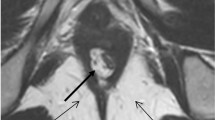Abstract
Eighteen patients with surgically corrected high (supralevator) anorectal anomalies were scanned by computerised tomography (CT) to assess the state of development of the anorectal sphincter muscle complex (SMC) and the position of the neorectum in relation to the SMC. These CT findings were compared with the patients' assessed grade of faecal continence/incontinence. While continence levels did not always correlate closely with CT findings, the presence of a deficient SMC or an eccentric position of the neorectum within it, or both, was more frequent in patients with continence problems. For severe incontinence, CT scanning gave helpful indications for or against secondary rectoplasty.
Similar content being viewed by others
References
Anderson RE (1989) Magnetic resonance imaging versus computed tomography — which one? Postgrad Med 85: 79–87
de Vries PA, Pena A (1982) Posterior sagittal anorectoplasty. J Pediatr Surg 17: 638–643
Hartl M (1972) A modified technique of gracilis plastie. Paediatr U Paedol [Suppl 2]: 99–107
Holschneider AM (1976) The problem of anorectal continence. Prog Pediatr Surg 9: 85–114
Ikawa H, Yokoyama J, Sanbonmatsu T, Hagane K, Endo M, Katsumata K, Kohda E (1985) The use of computerised tomography to evaluate anorectal anomalies. J Pediatr Surg 20: 640–644
Kiesewetter WB (1967) Imperforate anus. II. The rationale and technique of the sacro-abdomino-perineal operation. J Pediatr Surg 2: 106
Kohda E, Fujioka M, Ikawa H, Yokoyama J (1985) Congenital anorectal anomaly: CT evaluation. Radiology 157: 349–352
Leighton DM, de Campo M (1989) CT invertograms. Pediatr Radiol 19: 176–178
Leighton DM, de Campo M (1989) Uses of direct coronal pelvic CT. Australas Radiol 33: 157–159
Pickrell KL, Georziade N, Crawford H (1952) Construction of a rectal sphincter and restoration of anal continence by transplanting the gracilis muscle. Ann Surg 35: 853–862
Pringle KC, Sato Y, Soper RT (1987) Magnetic resonance imaging as an adjunct to planning an anorectal pull-through. J Pediatr Surg 22: 571–574
Rehbein F (1959) Operation for anal and rectal atresia with rectourethral fistula. Chirurgie 30: 417
Schärli AF (1988) Analysis of anal incontinence. Prog Pediatr Surg 17: 93–104
Smith ED (1988) In: Stephens FD, Smith ED, Paul NW (eds) Anorectal malformations in children: update 1988. Liss, New York, pp
Stephens FD, Smith ED (1971) anorectal malformations in children. Year Book Medical, Chicago, pp
Stephens FD, Smith ED (1986) Classification, identification, and assessment of anorectal anomalies. Pediatr Surg Int 1: 200–205
Author information
Authors and Affiliations
Additional information
Offprint requests to: R. Fowler
Rights and permissions
About this article
Cite this article
Ong, N.T., de Campo, M. & Rowler, R. Computerised tomography in the management of imperforate anus patients following rectoplasty. Pediatr Surg Int 5, 241–245 (1990). https://doi.org/10.1007/BF00169661
Issue Date:
DOI: https://doi.org/10.1007/BF00169661




